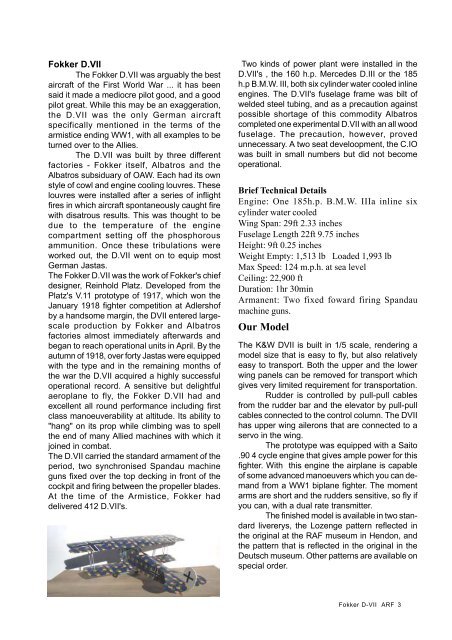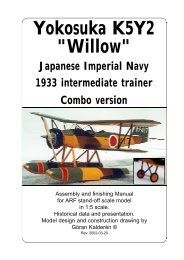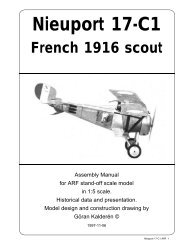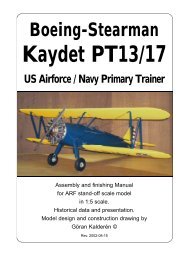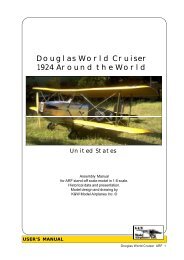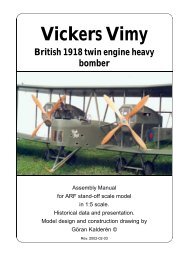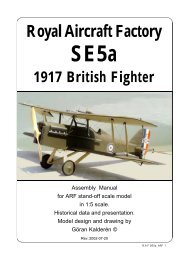Download PDF Manual - Macca's Vintage Aerodrome
Download PDF Manual - Macca's Vintage Aerodrome
Download PDF Manual - Macca's Vintage Aerodrome
You also want an ePaper? Increase the reach of your titles
YUMPU automatically turns print PDFs into web optimized ePapers that Google loves.
Fokker D.VIIThe Fokker D.VII was arguably the bestaircraft of the First World War ... it has beensaid it made a mediocre pilot good, and a goodpilot great. While this may be an exaggeration,the D.VII was the only German aircraftspecifically mentioned in the terms of thearmistice ending WW1, with all examples to beturned over to the Allies.The D.VII was built by three differentfactories - Fokker itself, Albatros and theAlbatros subsiduary of OAW. Each had its ownstyle of cowl and engine cooling louvres. Theselouvres were installed after a series of inflightfires in which aircraft spontaneously caught firewith disatrous results. This was thought to bedue to the temperature of the enginecompartment setting off the phosphorousammunition. Once these tribulations wereworked out, the D.VII went on to equip mostGerman Jastas.The Fokker D.VII was the work of Fokker's chiefdesigner, Reinhold Platz. Developed from thePlatz's V.11 prototype of 1917, which won theJanuary 1918 fighter competition at Adlershofby a handsome margin, the DVII entered largescaleproduction by Fokker and Albatrosfactories almost immediately afterwards andbegan to reach operational units in April. By theautumn of 1918, over forty Jastas were equippedwith the type and in the remaining months ofthe war the D.VII acquired a highly successfuloperational record. A sensitive but delightfulaeroplane to fly, the Fokker D.VII had andexcellent all round performance including firstclass manoeuverability at altitude. Its ability to"hang" on its prop while climbing was to spellthe end of many Allied machines with which itjoined in combat.The D.VII carried the standard armament of theperiod, two synchronised Spandau machineguns fixed over the top decking in front of thecockpit and firing between the propeller blades.At the time of the Armistice, Fokker haddelivered 412 D.VII's.Two kinds of power plant were installed in theD.VII's , the 160 h.p. Mercedes D.III or the 185h.p B.M.W. III, both six cylinder water cooled inlineengines. The D.VII's fuselage frame was bilt ofwelded steel tubing, and as a precaution againstpossible shortage of this commodity Albatroscompleted one experimental D.VII with an all woodfuselage. The precaution, however, provedunnecessary. A two seat develoopment, the C.IOwas built in small numbers but did not becomeoperational.Brief Technical DetailsEngine: One 185h.p. B.M.W. IIIa inline sixcylinder water cooledWing Span: 29ft 2.33 inchesFuselage Length 22ft 9.75 inchesHeight: 9ft 0.25 inchesWeight Empty: 1,513 lb Loaded 1,993 lbMax Speed: 124 m.p.h. at sea levelCeiling: 22,900 ftDuration: 1hr 30minArmanent: Two fixed foward firing Spandaumachine guns.Our ModelThe K&W DVII is built in 1/5 scale, rendering amodel size that is easy to fly, but also relativelyeasy to transport. Both the upper and the lowerwing panels can be removed for transport whichgives very limited requirement for transportation.Rudder is controlled by pull-pull cablesfrom the rudder bar and the elevator by pull-pullcables connected to the control column. The DVIIhas upper wing ailerons that are connected to aservo in the wing.The prototype was equipped with a Saito.90 4 cycle engine that gives ample power for thisfighter. With this engine the airplane is capableof some advanced manoeuvers which you can demandfrom a WW1 biplane fighter. The momentarms are short and the rudders sensitive, so fly ifyou can, with a dual rate transmitter.The finished model is available in two standardlivererys, the Lozenge pattern reflected inthe original at the RAF museum in Hendon, andthe pattern that is reflected in the original in theDeutsch museum. Other patterns are available onspecial order.Fokker D-VII ARF 3


